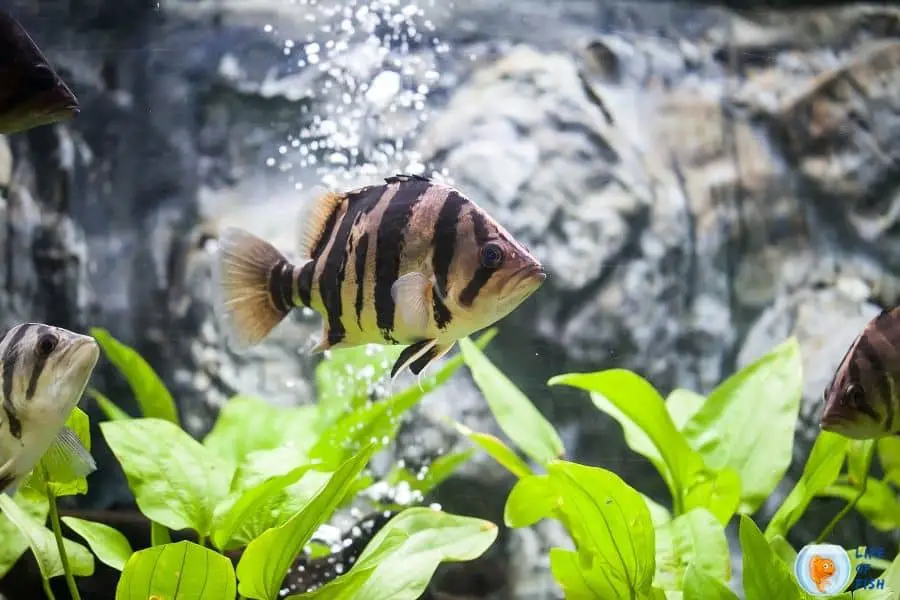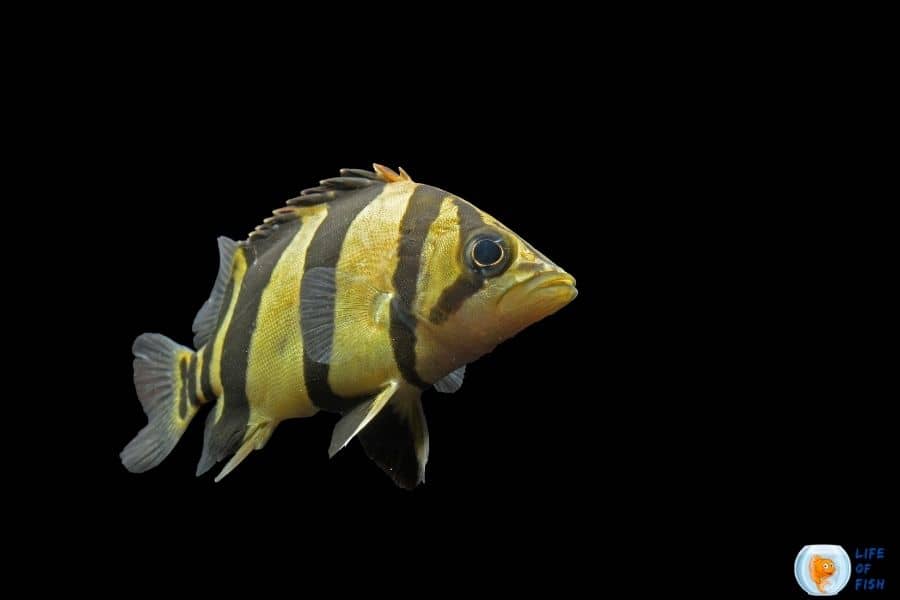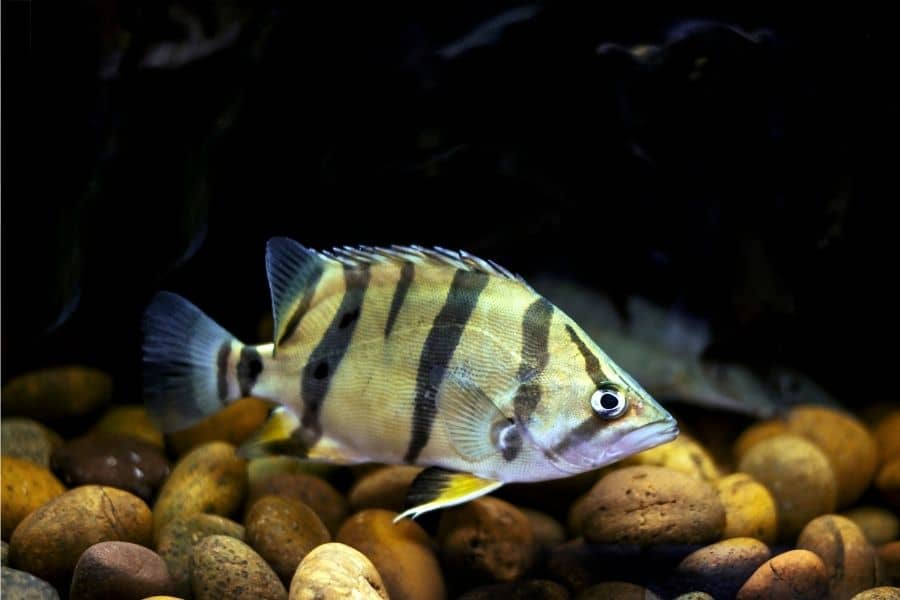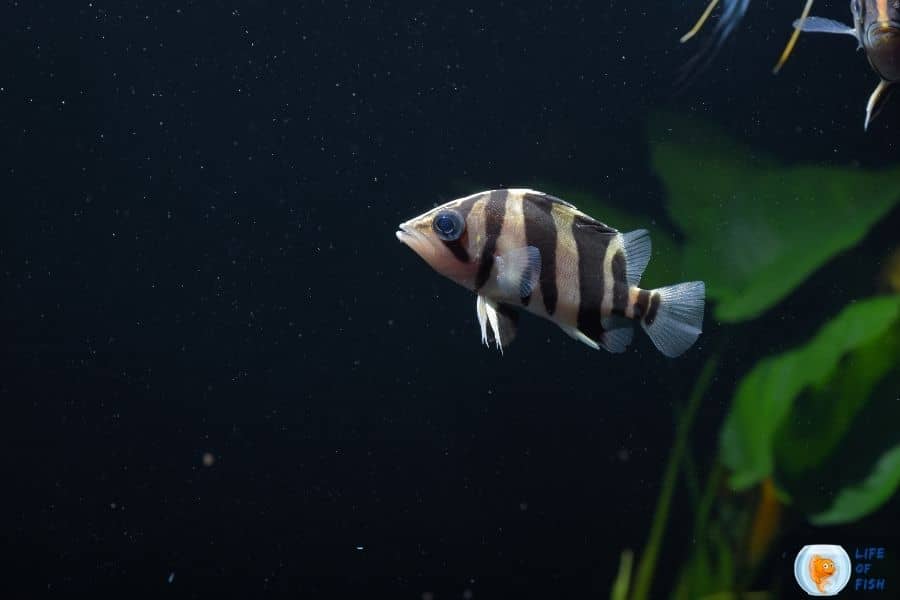Datnioides pulcher also known as Siamese Tiger Perch, Siamese Tigerfish, Widebar Tigerfish, Widebar Datnoid, Gold Datnoid, and several other names, are extremely rare fish species in the wild and aquarium trade.
It is a tropical freshwater fish native to the Mekong Basin in Thailand, Laos, and Cambodia.
These fish have an attractive color morph with four to five broad bars on the body, making them very sought-after by both freshwater aquarists and fish collectors.
If you are a hobbyist that prefers rare and exotic fish, Datnioides pulcher can be a perfect choice, but you must understand that these are not easy fish to keep.
This article is a guide for Datnioides pulcher care and will provide the reader with adequate knowledge to set up and maintain a healthy aquarium.

What is Datnioides pulcher or siamese tiger perch?
Jump To
- 1 What is Datnioides pulcher or siamese tiger perch?
- 2 Are Datnioides pulcher endangered?
- 3 How big do Datnioides pulcher get?
- 4 Is Datnioides pulcher aggressive?
- 5 Datnioides pulcher behavior
- 6 How long do Datnioides pulcher live?
- 7 One look care guide
- 8 Datnioides pulcher care
- 9 Datnioides pulcher breeding
- 10 Special tips
- 11 How to feed Datnioides pulcher?
- 12 What fish can live with Siamese Tiger Perch?
- 13 The Difference between the Siamese tiger perch (Datnioides pulcher) and the False Siamese tiger perch (Datnioides microlepis)
- 14 Related Questions
Datnioides pulcher is famous as Siamese Tiger Perch. It is a ray-finned fish endemic to the Mekong Basin in Thailand, Laos, and Cambodia.
Specific to southeast Asia. Siamese tiger perch is a member of the family Datnioididae.
There is some controversy about the genus name as some documents cite Datnoides while others use Datnioides.
Datnioides pulcher is a large species with an elongated body that can grow from 30 to 40 cm long (12 – 16 inches). Sizes of 70 cm have been reported but seem very rare.
The name of Siamese tiger perch derives from its most remarkable feature: the broad black bars clearly visible across the golden body.
There are 4 visible black bars on their body; 1 bar run through the opercle, 2nd bar middle of the dorsal spines to slightly in front of anal fin origin, 3 bar from the 9th dorsal spine to anal rays, and 4th one posterior half of the caudal peduncle.
Young specimens are even more attractive, with their dark blue to black stripes on a light pale silver-blue background.
As the fish matures, it will lose this coloration and turn into a plain golden color; some specimens may retain some faint traces of the characteristic pattern, but not many do.
The dorsal and anal fins are large and contain 12 to 15 spines each; the pelvic fins of these fish have one spine and five soft rays.
There is a long and strong maxillary barbel (the same color as the body) at the corners of its mouth.
Are Datnioides pulcher endangered?
Datnioides pulcher is unfortunately a critically endangered species that are very rare both in nature and the aquarium trade.
They have been classified as Critically Endangered on the IUCN Red List of Threatened Species since 2011.
In nature, their range is restricted to single river drainage, from the city of Pakse in southern Laos to Chiang Khan district in Thailand.
They were used to be widespread in Indochina but, was extirpated from Thailand since 1990. The populations are critically low in Cambodia, Viet Nam, and Lao PDR.
Therefore, local governments have implemented laws to restrict the catching or possessing of these species.
However, these fish are allowed to possess in the global aquarium trade.
How big do Datnioides pulcher get?
Datnioides pulcher can reach about 16 inches in the wild, but they tend to be smaller in captivity.
Some specimens grow past 10 inches, but it is very rare and takes several years for them to reach this size, depending on the conditions of the aquarium.

Is Datnioides pulcher aggressive?
Siamese tiger perches are semi-aggressive species.
They will do fine with similarly sized fishes but will be aggressive with the conspecifics and similar-shaped fish species.
Further, these fish are carnivore species. Therefore, they will prey on smaller-sized fish.
Datnioides pulcher behavior
Juveniles tend to form schools, but as they grow up, they tend to live in solitary.
Matured Siamese Tiger perches are not gregarious and become aggressive toward fish of the same species and similarly shaped fish like North Thailand Tigerfish.
However, they get along well with other similar-sized peaceful fish and can get intimidated by aggressive fish species.
Siamese tiger perches are carnivore species. In the wild, these fish species feed on other fishes.
You can feed them with small-sized fish or frozen food pellets perfected for carnivore species in captivity.
How long do Datnioides pulcher live?
Siamese tiger perch can live for around ten years in the wild, but they tend to be shorter-lived in captivity.
One look care guide
| Scientific name | Datnioides Pulcher |
| Common name | Siamese tiger perch, Siamese Tiger Fish, Widebar Tigerfish, Widebar Datnoid, Gold Datnoid, etc |
| Care level | Advanced |
| Native to | Mekong Basin in Thailand, Laos, and Cambodia |
| Type | Freshwater fish |
| Color | light red gold to yellow banana with three to four black broad bars |
| Tank size | 60 gallons for one fish, 100 gallons or more for a school |
| Preferred temperature | 72°F – 79°F |
| Other water parameters (ammonia ,ect) | pH: 6.5-7.5 hardness: °dGH 5 to 20 |
| Preferred salinity | No salinity |
| Size | Up to 16 inches |
| Life span | Up to 10 years |
| Temperament | Semi aggressive |
| Recommended tank mates | Peaceful large fish |
| Preferred food | Mainly piscivores. Fish, shrimp, and insects in the wild. In aquarium: frozen bloodworms (live or frozen), earthworms, mussels, prawns, krill, crickets, etc |
| Feeding frequency | For juveniles: several feedings per dayFor adults: 2 to 3 feedings per week |
| breeding | Impossible in home aquaria |
Datnioides pulcher care
These are very large-sized and very long-lived fish. They need a lot of space for swimming, lots of rockwork where they can rest, and plenty of hiding spaces between the rocks.
Lots of free water flow is also important since they would like to have constant water movement.
size
Siamese tiger perches can grow up to 16 inches in the wild but tend to grow smaller in captivity.
tank size
Siamese tiger perches are large fish species, requiring a giant aquarium, at least 100 gallons.
However, even when fully grown up, these fish are less active and more docile than their active counterparts, like North Thailand Tigerfish.
Therefore, they can be kept in smaller aquariums also, say around 75 gallons.
How many Siamese Tiger Perch should be kept together?
These fish will do best when kept alone with other fish species. However, you can keep about 5 Siamese Tiger perches or more in one aquarium if you prefer.
If you keep the same species of fish, ensure that the aquarium is densely planted.

Tank setup
Since these are freshwater fish species, you will have to set up a freshwater aquarium that mimics their natural habitats.
Substrate
Siamese tiger perches are mostly middle-dwelling fish, although they explore everywhere.
They will not bother with the substrate type, but sand or gravel works best with these fish because it is easier to clean the bottom if you use one of these substrates.
Plants and Decorations
Siamese tiger perches inhabits densely planted medium to large-sized streams and rivers.
They spend a lot of time hiding among the dense vegetation and current areas, except when hunting. Therefore, one will have to mimic these conditions in the aquarium.
A densely planted tank with hardy plants like Elodea or water wisteria is suitable for setting up a Siamese Tiger Perch aquarium.
Keeping these fish alone in the aquarium without plants tends to get these fish stressed out easily.
It is always better to provide some other hiding places like rocks, caves, and driftwood because these fish are shy in nature.
Lighting
You should well light Siamese Tiger Perch aquarium to provide a good view of your fish. These fish will do fine with normal moderate lighting as you provide shade with plantation.
Water Movement
While setting up the aquarium, ensure that there is enough water flow along with filtration and aeration for healthy living conditions of your fish. Low-flow areas will stress out the Siamese Tiger perches.
For the filtration, use a large canister filter because these fish produce a lot of waste, especially when large sized.
Water quality condition
The Siamese tiger perches inhabit a tropical climate and prefer a water temperature of 72°F – 79°F.
These fish species have high oxygen demands and require a well-oxygenated aquarium.
Hence, ensure to create water movement along with filtration and aeration for healthy living conditions of your Siamese Tiger Perch.
You should maintain normal tropical freshwater tank water parameters such as pH 6.5-7.5, °dGH 5 to 20 in the aquarium because Siamese Tiger perches prefer to live in an acidic environment.
These fish are exclusively freshwater fish. However, they can tolerate very slightly brackish waters for some time.
Siamese tiger perches are very large-sized and active species, so the water quality should be pristine. Hence, weekly 30% of water change along with gravel vacuuming is essential.
Datnioides pulcher breeding
Siamese Tiger Perch male or female identification
These fish do not show sexual dimorphism. Therefore, identifying male and female fish is almost impossible unless you witness spawning or see eggs.
Siamese Tiger Perch breeding
Breeding of Siamese tiger perch is impossible in home aquaria. Since these fish are extinct in their native waters, the Thailand government has taken steps to reproduce them in nature but has had no success.
However, one commercial breeder had success breeding these fish in captivity after ten years of experiment.
How they breed or how many they produce is still a secret, but this breeder confirms that they can only breed these fish once per year.
Further, the number of offspring is very low. Therefore, they sell these fish at super high prices because they are the only known Siamese Tiger Perch breeders in the world.
According to their FB records, the price per fish was $3000+ over a year ago.
Special tips
When these fish are stressed, their body becomes darker, and the broad bars become less distinct.
If you observe these signs in your fish, you must take action immediately. Check for water quality conditions immediately and make amends.
How to feed Datnioides pulcher?
Siamese tiger fiah are carnivorous (mainly piscivore) fish species. They feed on fish, shrimp, and insects in the wild.
Siamese Tigerfish love hunting and feeding on live food, so provide them a diet consisting of meaty foods such as frozen bloodworms (live or frozen), earthworms, mussels, prawns, krill, crickets, etc.
While juvenile fish require daily feedings, older fish do not. For older fish, 2 to 3 times feedings per week are enough.
Do not feed mammalian or avian meat (e.g., chicken, beef heart) to Siamese tiger perches because they are not able to digest mammalian meat.
Fish can not properly metabolize the lipids contained in these meats. These meats may cause excess fat deposits and organ degeneration, causing the fish serious health issues.
Feeding “feeder fish” like small goldfish and mollies is of no use either because they tend not to have high nutritional value and may carry harmful parasites or diseases.

What fish can live with Siamese Tiger Perch?
These fish require a larger aquarium in order to live with other fishes. They tend to be aggressive toward their own species and similar-shaped species (like other tigerfish species).
So, housing these fish with such fish is not a good idea. If you prefer to have more than one Siamese tiger perches, then add five or more fish together to avoid aggression.
You can not house small fishes, shrimps, crabs, and snails because these fish may consider them as food and eat them.
If a fish is small enough to fit in their mouth, then they will be snacks for Siamese tiger perches.
Good tank mates for Siamese tiger perches are large peaceful fishes like freshwater stingrays, archers, green chromides, big sleeper gobies, giant gouramis, red-tailed catfish, and so on.
Since these are somewhat shy fish species, housing them with aggressive fish species is not good.
Though Siamese tiger perches are not known for being fin nippers because they have large mouths, even little nips from them may cause damage to other fishes.
Therefore, avoid housing these fish with long-finned fishes.
Their aggression is more towards their own species and fishes with similar body shapes/patterns. Hence, you can house them with other large fishes unless they are aggressive.
The Difference between the Siamese tiger perch (Datnioides pulcher) and the False Siamese tiger perch (Datnioides microlepis)
According to experts, there are distinct differences between the true Siamese tiger perch and the false one (Indonesian tiger perch).
The true Siamese tiger perch has a distinct color, ranging from light red gold to yellow banana (without lighting).
The body is more elevated because the transition from head to mouth is more acute. The bars are deeper black.
The false Siamese tiger perch (Datnioides microlepis) has a more whitish-yellow tint and a longer body in adult size. The shape of the mouth is also different.
Embedded code for the original post.
Related Questions
Are Siamese Tiger Perch rare?
Siamese tiger perches are super rare and critically endangered species. As of now, there is only one commercial breeder that can breed these fish in captivity because the breeding technique is being kept a secret.
These fish are already extinct in their natural habitats in Thailand due to habitat loss, over-fishing, and pollution.
Although the Thailand government is struggling to protect this species by artificially breeding them, there has been no success.
How long does Siamese Tiger Perch live?
The expected lifespan of wild-caught fish is around ten years. However, with good care in the aquarium, these fishes may live longer than that.
Usually, they tend to become ill or die due to poor water conditions and malnutrition. You should keep Siamese tiger perches in a larger aquarium to ensure their health and longevity.
How much is a Siamese Tiger Perch?
Siamese tiger perches are extremely rare fish species. They are not commonly found in aquarium stores, so it is hard to know the exact price. But expect it to be over USD 3000.
Read Next : Scat Fish | 14 Impressive Facts About This Fascinating Fish |
